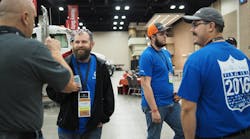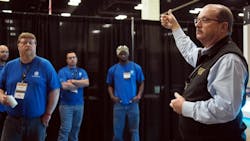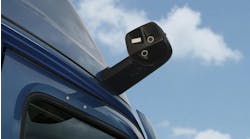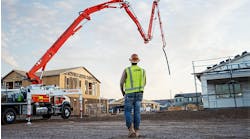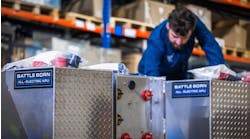SAN ANTONIO. Mike McRoberts, senior vice president and chief operating officer for Rush Enterprises, will tell you that while his company uses its annual rodeo skills competition as a recruiting and retention tool for technicians with all levels of experience, other tools are needed as well – especially technology and the ability to learn and growth in technician trade.
“[The rodeo] is one tool in our toolbox; we work on multiple fronts,” he explained to Fleet Owner here during the 2016 Rush Technician Skills Rodeo event. “Our philosophy is that service sells trucks, but it can lose trucks, too. The number one issue our customers focus on today is [truck] dwell time in the shop. So in addition to hiring and keeping the best technicians, it’s about using technology and systems – along with good internal processes – in real time to meet that [customer] demand.”
Examples of that technological piece of truck service puzzle include the company’s RushCare Service Connect system, introduced earlier this year.
W.M. "Rusty" Rush, chairman, CEO, and president of Rush Enterprises, boiled that philosophy down in an interview during the company’s rodeo event three years ago.
“Look, consistency is what people want, in life as well as in business,” he explained.
“In three or four years, selling trucks won’t be about sticker prices; it will be about business pressure points and how we help the customer maximize uptime,” Rush noted. “If we can keep a truck up and running 29.2 days out of month versus a competitor’s 28.5 days per month, that 7/10ths of a day per month makes a huge difference in life cycle cost and will be what sets us apart.
Yet Charlie Wileman, director of service for Rush’s Navistar division, stressed that the technician remains at the heart of the service equation, and that events such as the company’s skills rodeo – which is now “a seven figure event; we don’t spare any expense,” he stressed – are critical to building both the morale and the culture of Rush’s technician corps.
“My favorite part is the camaraderie,” he told Fleet Owner. “It gets everyone involved; it puts out executives, our sponsors and technicians together to rub elbows. It also speaks volumes as to what our message is in terms of the important role of [truck] service in our company.”
Ron Crisp, Rush’s service support specialist for medium-duty, noted that the company’s annual rodeo is also becoming a key recruiting and retention tool for younger technicians – the Level 1 and 2 techs that industry needs to bring into the business to replace those retiring.
“This event has a real impact; I’ve seen our retention of younger techs reach about 80%,” he told Fleet Owner. “The look on their face when they walk into this competition is a ‘wow’ factor, and then they go back and tell their friends about it.”
Rush’s McRoberts said including younger technicians in the rodeo competition though its “Rising Star” category launched several years ago is partly an effort to increase their retention rate.
“Most of the [rodeo] winners are our experienced techs; we’re sensitive to that,” he explained. “So we created a category where we can bring in just Level 1, 2 and 3 technicians to give them a taste of what it is like; to give them a goal to aim for.”
McRobert said the real “beauty” of mixing the more experienced Level 5 technicians with Levels 1 and 2 techs in the rodeo is that they all learn something and share that learning when they return to their home bases.
“Ideally, that’s what we want to see in our organization,” he said.
